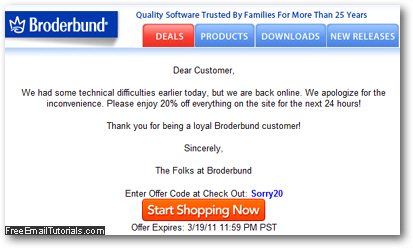Managing Mistakes: Email Marketing Blunders
Your biggest failure as an email marketer is to send a newsletter containing mistakes or inaccuracies. But it can happen, and the substance of this section is to help you come back from such a blunder: the way in which you handle such an embarrassment will leave many with a lasting impression. The power of email marketing can in such case turn against you: a simple email broadcast can reach a few thousand subscribers.
How to Manage Errors
Short of ignoring the blunder, there are two ways in which you manage errors. These courses of action are relevant so long as your newsletters do not contain information likely to endanger lives; in doubt, seek legal counsel.
That caveat aside, and as we mentioned in earlier email marketing tutorials, humor is magic: it is your way to present an embarrassing situation to your advantage, or at least show how fun and friendly your company is by the way it handles a blunder.
Turning lemons into lemonade
Here's a great example we received the other day, an excellent way to turn a negative into a positive: the post-1960 consumer is very skeptical and prompt to imagine malice or cynicism, so do ensure that your own server outages are genuine and far apart!
(We focus here on the content of the message, not the presentation of the newsletter.)
Standalone Apology
Sending an email marketing newsletter is akin to door-to-door soliciting, except that subscribers have authorized you to email them. At any rate, any email is a disturbance, and should only be sent when absolutely necessary or worthwhile. If you wish to address the mistake you made in your newsletter, only do it as a personal apology from one of your senior staff writer or editor. Do not re-send a corrected copy of the newsletter.
Follow-up Errata
If the inaccuracy or mistake made in the newsletter will not have serious consequences, let it go. But make it a point to start your next newsletter with a correction, or an apology if it is called for. Avoid starting with "many of you emailed us about", which makes you appear reactive and unprofessional, rather than proactive and in control. Instead, say something like "we realized that", which makes subscribers feel that you are on top of the situation.